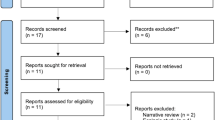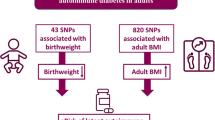Abstract
The four models proposed for exploring the foetal origins of adult disease (FOAD) hypothesis use the product term between size at birth and current size to determine the relative importance of pre- and post-natal growth on disease in later life. This is a common approach for testing the interaction between an exposure (in this instance size at birth) and an effect modifier (in this instance current size)—incorporating the product term obtained by multiplying the exposure and effect modifier variables within a statistical regression model. This study examines the mathematical basis for this approach and uses computer simulations to demonstrate two potential statistical flaws that might generate misleading findings. The first of these is that the expected value of the partial regression coefficient for the product term (between exposure and effect modifier) will be zero when the outcome, exposure and effect modifier are all continuously distributed and follow a multivariate normal distribution. This is because testing the product interaction term amounts to testing for multivariate normality among the three variables, irrespective of the pair-wise correlations amongst them. The second flaw is that it is possible to generate a statistically significant interaction between exposure and effect modifier, even when none exists, simply by categorising either or both of these variables. These flaws pose a serious challenge to the four models approach proposed for exploring the FOAD hypothesis. The interaction between exposure and effect modifier variables should be interpreted with caution both here and elsewhere in epidemiological analyses.
Similar content being viewed by others
References
Barker DJP. Developmental origins of adult health and disease. J Epidemiol Commun Health 2004;58:114–5.
Leon DA, Koupilova I, Lithell HO, Berglund L, Mohsen R, Vagero D, et al. Failure to realise growth potential in utero and adult obesity in relation to blood pressure in 50 year old Swedish men. BMJ 1996;312:401–6.
Barker DJP. The fetal origins of type 2 diabetes mellitus. Ann Intern Med 1999;130:322–4.
Huxley RR, Shiell AW, Law CM. The role of size at birth and postnatal catch-up growth in determining systolic blood pressure: a systematic review of the literature. J Hypertens 2000;18:815–31.
Huxley RR, Neil A, Collins R. Unravelling the fetal origins hypothesis: is there really an inverse association between birthweight and subsequent blood pressure? Lancet 2002;360:659–65.
Tu YK, West R, Ellison GTH, et al. Why evidence for the fetal origins of adult disease might be a statistical artifact: the “reversal paradox” for the relation between birth weight and blood pressure in later life. Am J Epidemiol 2005;161:27–32.
Cole TJ. A critical evaluation of the fetal origins hypothesis and its implications for developing countries. J Nutr 2004;134:201–4.
Vagero D, Illsley R. Explaining health inequalities. Beyond Black and Barker—a discussion of some issues emerging in the decade following the Black report. Eur Sociolog Rev 1995;11:219–41.
Lucas A, Fewtrell MS, Cole TJ. Fetal origins of adult disease—the hypothesis revisited. BMJ 1999;319:245–9.
Tu YK, Ellison GTH, Gilthorpe MS. What is the effect of adjusting for more than one measure of current body size on the relation between birthweight and blood pressure? J Hum Hypertens 2006;20:646–57.
Paneth N, Susser M. Early origin of coronary heart disease (the “Barker hypothesis”). BMJ 1995;310:411–2.
Paneth N, Ahmed F, Stein AD. Early nutritional origins of hypertension: a hypothesis still lacking support. J Hypertens 1996;14:S121–9.
Walker SP, Gaskin P, Powell CA, Bennett FI, Forrester TE, Grantham-McGregor S. The effects of birth weight and postnatal linear growth retardation on blood pressure at age 11–12 years. J Epidemiol Commun Health 2001;55:394–8.
Williams S, Poulton R. Birth size, growth, and blood pressure between the ages of 7 and 26 years: failure to support the foetal origins hypothesis. Am J Epidemiol 2002;155:849–52.
Burke V, Beilin LJ, Blake KV, Doherty D, Kendall GE, Newnham LI, Stanley FJ. Indicators of foetal growth do not independently predict blood pressure in 8-year-old Australians: a prospective cohort study. Hypertension 2004;43:208–13.
Davies AA, Davey Smith G, Ben-Shlomo Y, Litchfield P. Low birth weight is associated with higher adult total cholesterol concentration in men: findings from an occupational cohort of 25,843 employees. Circulation 2004;110:1258–62.
Cox DR, Small NJH. Testing multivariate normality. Biometrika 1978;65:263–72.
Cox DR, Wermuth N. Tests of linearity, multivariate normality and the adequacy of linear scores. Appl Statist 1994;43:347–55.
Cox DR. Note on grouping. J Am Statist Assoc 1957;52:543–7.
Zhao LP, Kolonel LN. Efficiency loss from categorising quantitative exposures into qualitative exposures in case-control studies. Am J Epidemiol 1992;136:464–74.
MacCallum RC, Zhang S, Preacher KJ, Rucker DD. On the practice of dichotomisation of quantitative variables. Psychological Methods 2002;7:19–40.
Taylor JMG, Yu M. Bias and efficiency loss due to categorising an explanatory variable. J Multivariate Anal 2002;83:248–63.
Cumsille F, Bangdiwala SI, Sen PK, Kupper LL. Effect of dichotomising a continuous variable on the model structure in multiple linear regression models. Commun Statist-Theory Meth 2000;29:643–54.
R Development Core Team. R: A language and environment for statistical computing. R Foundation for Statistical Computing, Vienna, Austria, 2005. ISBN 3-900051-07-0, URL http://www.R-project.org.
Hennessy E, Alberman E. Intergenerational influences affecting birth outcome. II. Preterm delivery and gestational age in the children of the 1958 British birth cohort. Pediatr Perinat Epidemiol 1998;12(Suppl 1):61–75.
Ripley BD, Venables WN. Modern applied statistics with S. 4th ed. New York: Springer Verlag; 2002.
Tu YK, Ellison GT, Gilthorpe MS. Growth, current size and the role of the ‘reversal paradox’ in the foetal origins of adult disease: an illustration using vector geometry. Epidemiol Perspect Innov 2006;3:9.
Tu YK, Gilthorpe MS. Unexplained residuals models are not solutions to statistical modeling of the fetal origins hypothesis (letter to the editor). J Clin Epidemiol 2007;60:318–9.
De Stavola BL, Nitsch D, dos Santos Silva I, McCormack V, Hardy R, Mann V, Cole TJ, Morton S, Leon DA. Statistical issues in life course epidemiology. Am J Epidemiol 2006;163:84–96.
Sandhu J, Davey Smith G, Holly J, Cole TJ, Ben-Shlomo Y. Timing of puberty determines serum insulin-like growth factor-I in late adulthood. J Clin Endocrinol Metab 2006;91:3150–7.
West RM, Harris K, Gilthorpe MS. Lifecourse functions: a functional data approach to lifecourse analysis. Pediatr Res 2005;58:1050.
Weisberg S. Applied linear regression. 2nd ed. New York: Wiley; 1985.
Bohrnstedt GW, Goldberger AS. On the exact covariance of products of random variables. J Am Statist Assoc 1969;64:1439–42.
Anderson TW. An introduction to multivariate statistical analysis. 3rd ed. New Jersey: Wiley; 2003, pp 46.
Author information
Authors and Affiliations
Corresponding author
Appendix: derivation of the correlations between XZ and, Y, X and Z
Appendix: derivation of the correlations between XZ and, Y, X and Z
Take three multivariate normal random variables X, Y, and Z, where Y is the outcome in a regression model with X and Z and their product interaction term (XZ) as covariates:
where B 0 is the intercept; B 1 the partial regression coefficient for X; B 2 the partial regression coefficient for Z; B 3 the partial regression coefficient for XZ; and ε the residual error. To prove that the partial regression coefficient for product interaction term XZ is zero, under the assumption of multivariate normality and irrespective of pair-wise correlations amongst Y, X and Z, it is sufficient to prove that the standardized partial regression coefficient for XZ (β 3) is zero. Using matrix algebra for the regression model [32], one can write:
where: Y is a vector (n × 1) of standardized Y values; A is a matrix (n × 3) of standardize X, Z and XZ covariate values; B is a vector (3 × 1) of the standardized partial regression coefficients; and the prime, ′, denotes the matrix transpose. Furthermore, denoting \( {\mathbf{M}} = {\left( {{\mathbf{A}}^{{ - {\mathbf{1}}}} {\mathbf{A}}} \right)} \), M is therefore the correlation matrix for the three covariates. Thus,
Solving Eq. A2 for the coefficient β 3, according to standard matrix algebra (27):
where: \( \det ({\bf{M}}) = 1 + 2r_{{X,Z}} r_{{X,XZ}} r_{{Z,XZ}} - r^{2}_{{X,Z}} - r^{2}_{{X,XZ}} - r^{2}_{{Z,XZ}} \) is the matrix determinant of M; and r a,b is the correlation between a and b, substituting X, Y, Z, or XZ for a and b as appropriate.
Under the assumption of multivariate normality, it can be shown that [33, 34]:
where: σ a,b is the covariance of a and b; E(a) the expected value of a; and \( \sigma ^{2}_{a} \) the variance of a, again substituting X, Y, Z, or XZ for a and b as appropriate.
Now, denoting \( V_{X} = {\sigma _{X} } \mathord{\left/ {\vphantom {{\sigma _{X} } {E(X)}}} \right. \kern-\nulldelimiterspace} {E(X)} \) and \( V_{Z} = {\sigma _{Z} } \mathord{\left/ {\vphantom {{\sigma _{Z} } {E(Z)}}} \right. \kern-\nulldelimiterspace} {E(Z)} \), where E(X) ≠ 0 and E(Z) ≠ 0 (which can be guaranteed by adding an arbitrary constant to X or Z), writing \( D = {\sqrt {V^{2}_{X} + V^{2}_{Z} + 2r_{{X,Z}} V_{X} V_{Z} + V^{2}_{X} V^{2}_{Z} (1 + r^{2}_{{Y,X}} )} } \), and utilising Eq. A4, the correlations between X and XZ (r X,XZ ), Y and XZ (r Y,XZ ), and Z and XZ (r Z,XZ ) can be written:
and Eq. A3 then becomes:
Testing the product term is thus to test the linearity and multivariate normality of the three continuous variables [17, 18]. The interaction effect is scale-dependent since transformation of the original variables can attenuate the interaction coefficient or produce a non-zero effect that is otherwise zero for the original variables.
Rights and permissions
About this article
Cite this article
Tu, YK., Manda, S.O.M., Ellison, G.T.H. et al. Revisiting the interaction between birth weight and current body size in the foetal origins of adult disease. Eur J Epidemiol 22, 565–575 (2007). https://doi.org/10.1007/s10654-007-9159-5
Received:
Accepted:
Published:
Issue Date:
DOI: https://doi.org/10.1007/s10654-007-9159-5




